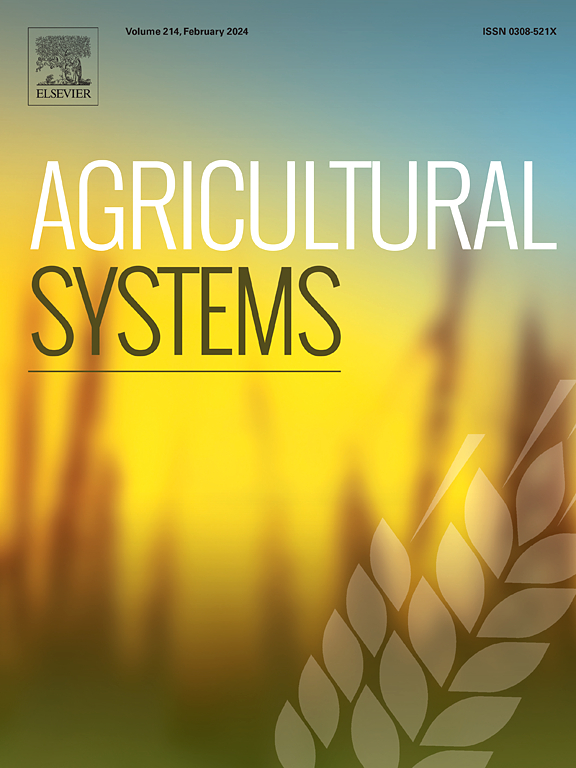利用生物废弃物可持续水培网瓜(Cucumis melo L.)的挑战与机遇
IF 6.1
1区 农林科学
Q1 AGRICULTURE, MULTIDISCIPLINARY
引用次数: 0
摘要
循环农业旨在促进资源循环利用,以实现可持续的环境。用生物废物替代品替代化学投入是促进可持续农业的一项切实可行的战略,特别是在水培系统中,可以在资源有限的条件下实现高效生产。网瓜(Cucumis melo L.)是高经济价值的作物,这为探索这些替代品提供了机会。然而,在水培中使用生物废物需要额外的预处理过程,并可能导致果实重量降低,影响环境和经济结果。目的评价生物废弃物部分替代常规肥料在水培甜瓜栽培中的环境影响。方法采用生命周期评价(LCA)方法,对水培网瓜栽培中以20%的生物废弃物(粉虫粪)代替常规肥料(合成化学品)的效果进行评价。首先进行了实际试验,以衡量生物废物替代对植物生长和作物产量的影响。然后,在本研究中进行了扩大分析,以包括季节变化。结果与结论水培网瓜栽培中生物废弃物替代常规肥料可使环境总影响提高11.3 ~ 13.7%。这一增长主要归因于生物废物预处理对能源的额外需求和水果重量的减少,导致温室气体(GHG)排放量增加2.1%。特别是,虽然生物废物替代减少了20.0 - 30.7%的矿物资源稀缺性,但全球变暖潜势增加了11.6 - 14.2%。此外,我们最初预计在实施生物废物替代时将减少8.2%的温室气体排放,但额外的能源需求和减少的水果重量抵消了这些好处。本研究强调了水培系统中生物废物替代的潜力和挑战。这说明施用生物废物肥料时无土栽培条件不稳定。随着水培农业在循环农业系统中的不断发展,需要仔细考虑粮食生产力和能源需求,以实现农业系统的环境可持续性。本文章由计算机程序翻译,如有差异,请以英文原文为准。

Challenges and opportunities in using biowaste for sustainable hydroponic netted melon (Cucumis melo L.) cultivation
CONTEXT
Circular agriculture aims to promote resource recycling for a sustainable environment. Substituting chemical inputs with biowaste alternatives is a practical strategy for fostering sustainable agriculture, especially in hydroponic systems that enable efficient production under resource-limited conditions. Netted melons (Cucumis melo L.) are high-economic-valued crops, which represents an opportunity to explore these substitutions. However, using biowaste in hydroponics requires additional pretreatment processes and may lead to lower fruit weights, impacting both environmental and economic outcomes.
OBJECTIVE
This study aimed to evaluate the environmental impacts of partially substituting conventional fertilizers with biowaste fertilizers in hydroponic melon cultivation.
METHODS
This study performed a life cycle assessment (LCA) to assess the effects of substituting 20 % biowaste (mealworm frass) for conventional fertilizers (synthetic chemicals) in hydroponic netted melon cultivation. The practical trials were first carried out to measure the impacts of biowaste substitution on plant growth and crop yields. Then, scaled-up analyses were conducted to include seasonal variability in this study.
RESULTS AND CONCLUSIONS
Biowaste Substitution for conventional fertilizers in hydroponic netted melon cultivation increased the total environmental impacts by 11.3–13.7 %. This increase was primarily attributed to additional energy requirements for biowaste pretreatment and reduced fruit weight, leading to a 2.1 % rise in greenhouse gas (GHG) emissions. In particular, although biowaste substitution reduced mineral source scarcity by 20.0–30.7 %, the global warming potential increased by 11.6–14.2 %. Also, we initially expected to reduce GHG emissions by 8.2 % when implementing biowaste substitution, but additional energy requirements and reduced fruit weights offset the benefits.
SIGNIFICANCE
This study highlights both the potential and challenges of biowaste substitution in hydroponic systems. This illustrated the unstable conditions in soilless cultivation when applying biowaste fertilizers. As hydroponic farming continues to advance within circular agricultural systems, careful consideration is required for food productivity and energy requirements to achieve environmental sustainability in agriculture systems.
求助全文
通过发布文献求助,成功后即可免费获取论文全文。
去求助
来源期刊

Agricultural Systems
农林科学-农业综合
CiteScore
13.30
自引率
7.60%
发文量
174
审稿时长
30 days
期刊介绍:
Agricultural Systems is an international journal that deals with interactions - among the components of agricultural systems, among hierarchical levels of agricultural systems, between agricultural and other land use systems, and between agricultural systems and their natural, social and economic environments.
The scope includes the development and application of systems analysis methodologies in the following areas:
Systems approaches in the sustainable intensification of agriculture; pathways for sustainable intensification; crop-livestock integration; farm-level resource allocation; quantification of benefits and trade-offs at farm to landscape levels; integrative, participatory and dynamic modelling approaches for qualitative and quantitative assessments of agricultural systems and decision making;
The interactions between agricultural and non-agricultural landscapes; the multiple services of agricultural systems; food security and the environment;
Global change and adaptation science; transformational adaptations as driven by changes in climate, policy, values and attitudes influencing the design of farming systems;
Development and application of farming systems design tools and methods for impact, scenario and case study analysis; managing the complexities of dynamic agricultural systems; innovation systems and multi stakeholder arrangements that support or promote change and (or) inform policy decisions.
 求助内容:
求助内容: 应助结果提醒方式:
应助结果提醒方式:


